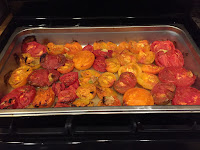Fresh, spreadable fruit in the form of jam, jelly, preserves, or marmalade, might possibly be summer's sweetest reward. The best part is that they are easy to make and can be enjoyed long after you put your garden to bed. So, what is the difference between each of these spreadable options?
Before we dive in, it helps to know that there are two main factors that turn fruit into a thick, spreadable texture: heat (from cooking) and pectin. When fruit is heated, it will lose liquid, causing the fruit to reduce to a firmer state. Pectin is naturally-occurring in fruit and happens to also make fruit thicken when cooked. However, not all fruit contains enough pectin to reach a firm texture, so many spreadable fruit recipes call for additional pectin.
Jelly:Jelly is the firmest and clearest of the sweet, spreadable options. The fruit is cooked and strained so only the juice ends up in the final product. Jelly is so firm that you could turn the jar over and slide the jelly out in one solid piece.
Jam:
Jam is a chunkier version of jelly. Jam has more fruit pieces and is slightly looser in texture. Chopped or pureed fruit is cooked with sugar, so pieces of fruit end up in the final product. Jams are not clear and not solid like their jelly cousin.
Preserves:
Preserves are like jam but contain more and bigger pieces of fruit. Preserves have the least gel-like consistency. They are great for serving with cheeses and meat dishes.
Marmalade:
Marmalade is a preserve, but it is made only with citrus. The whole fruit, rind and all, create a bitter-sweet spreadable delight. Lemon, orange, and grapefruit make great marmalades. Marmalades are aromatic with complex flavors and oils from the citrus peels.
Jam, jelly, preserves, and marmalade start out almost the same, but take different forms depending on how they are processed. Whether you like your fruit a spreadable solid, with small pieces of fruit, with large pieces of fruit, or you want the complex flavors of citrus, there is always something good you can choose to put on your toast.


.png)
.png)









